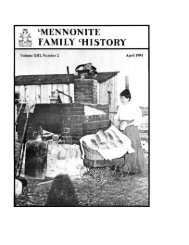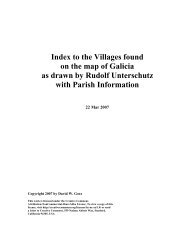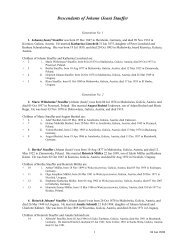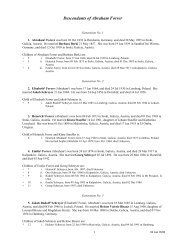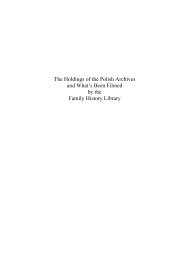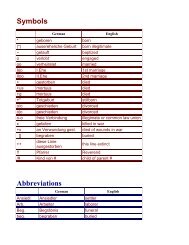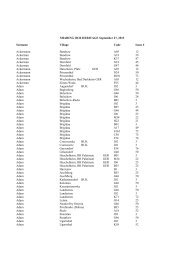Introduction to and Description of the Galician Family Study
Introduction to and Description of the Galician Family Study
Introduction to and Description of the Galician Family Study
You also want an ePaper? Increase the reach of your titles
YUMPU automatically turns print PDFs into web optimized ePapers that Google loves.
The <strong>Galician</strong> <strong>Family</strong> <strong>Study</strong>, <strong>Introduction</strong> & <strong>Description</strong><br />
<strong>Galician</strong> <strong>Family</strong> <strong>Study</strong><br />
<strong>Introduction</strong>: The partition <strong>of</strong> Pol<strong>and</strong> <strong>to</strong>ok<br />
place in 1772. It was divided among Russia,<br />
Prussia <strong>and</strong> Austria. Joseph II, Emperor <strong>of</strong><br />
Austria, wished <strong>to</strong> place skilled farmers in his<br />
terri<strong>to</strong>ry. In 1781, he appealed <strong>to</strong> <strong>the</strong><br />
Mennonite community in <strong>the</strong> German<br />
Palatinate <strong>to</strong> relocate <strong>to</strong> an area called Galicia,<br />
Austria. He granted numerous concessions<br />
relating <strong>to</strong> <strong>the</strong>ir doctrine <strong>and</strong> <strong>of</strong>fered o<strong>the</strong>r<br />
incentives for <strong>the</strong>m <strong>to</strong> come. They were settled<br />
on well-equipped homesteads made available<br />
with liberal terms. Of some 3,300 German<br />
families that accepted this <strong>of</strong>fer <strong>and</strong> o<strong>the</strong>r<br />
<strong>of</strong>fers, 28 families from <strong>the</strong> Alsace, Palatinate,<br />
<strong>and</strong> Montbeliard relocated <strong>to</strong> <strong>the</strong> vicinity <strong>of</strong><br />
Lemberg, Galicia, Austria. [Now part <strong>of</strong><br />
Ukraine <strong>and</strong> named Lwow.] 15 <strong>of</strong> <strong>the</strong>se<br />
families <strong>of</strong> Swiss <strong>and</strong> German descent located<br />
<strong>to</strong> new communities located around Lemberg,<br />
where <strong>the</strong>y lived in peace <strong>and</strong> prospered for<br />
about 100 years.<br />
100 years later, <strong>the</strong>re were 144 Mennonite<br />
families in Galicia. As <strong>the</strong> population<br />
increased, <strong>the</strong>re was a need for additional<br />
homesteads. There also was a shift in <strong>the</strong><br />
attitude <strong>of</strong> <strong>the</strong> ruling governments. The young<br />
men were no longer exempt from military<br />
service.<br />
70 families moved <strong>to</strong> America in <strong>the</strong> period <strong>of</strong><br />
1880-1890. They found settlements at<br />
Arling<strong>to</strong>n <strong>and</strong> Hans<strong>to</strong>n, Kansas. In 1882, <strong>the</strong><br />
Winona <strong>and</strong> St. Peter Railway Company<br />
advertised in Europe for settlers <strong>to</strong> develop<br />
property along <strong>the</strong>ir right <strong>of</strong> way. They <strong>of</strong>fered<br />
1,160,000 acres <strong>of</strong> choice farming l<strong>and</strong> for $2<br />
<strong>to</strong> $8 an acre in sou<strong>the</strong>rn Minnesota <strong>and</strong><br />
eastern Dakota. This enticed additional<br />
families <strong>to</strong> leave Galicia, Austria <strong>and</strong> come <strong>to</strong><br />
<strong>the</strong> United States. Some settled in Kansas <strong>and</strong><br />
o<strong>the</strong>rs in Minnesota.<br />
1<br />
Those that came <strong>to</strong> Minnesota were comprised<br />
<strong>of</strong> 22 families. They settled in Westbrook,<br />
Butterfield, Rosehill, <strong>and</strong> Des Moines River<br />
Township around 1882. Many <strong>of</strong> <strong>the</strong>ir<br />
descendants still live in <strong>the</strong> area while o<strong>the</strong>rs<br />
have dispersed <strong>to</strong> Kansas, Iowa, California,<br />
Canada, <strong>and</strong> elsewhere. This study is<br />
addressed <strong>to</strong> that group <strong>of</strong> settlers.<br />
Control <strong>of</strong> Galicia was returned <strong>to</strong> Pol<strong>and</strong> in<br />
1919 after World War I. After <strong>the</strong> Russian-<br />
German treaty was signed in 1939, <strong>the</strong> area<br />
was ceded <strong>to</strong> Russia. All Germans were<br />
evacuated <strong>to</strong> western Pol<strong>and</strong>. In 1945, <strong>the</strong>y left<br />
<strong>the</strong>ir home <strong>and</strong> went west as <strong>the</strong> Russian<br />
armies swept through <strong>the</strong> area. About a third<br />
<strong>of</strong> <strong>the</strong> surviving Mennonites lost <strong>the</strong>ir lives at<br />
this time. In 1948, many resettled in Uruguay<br />
with <strong>the</strong> Danzig Mennonite community. Many<br />
<strong>of</strong> <strong>the</strong>se later returned <strong>to</strong> Germany <strong>to</strong> live out<br />
<strong>the</strong> rest <strong>of</strong> lives in what <strong>the</strong>y considered <strong>the</strong>ir<br />
homel<strong>and</strong>.<br />
Centennial Celebration: Arnold Bachmann<br />
published <strong>the</strong> book Galizien Mennoniten in<br />
W<strong>and</strong>el der Zeiten in Germany in 1984. This<br />
work was done in conjunction with people on<br />
both sides <strong>of</strong> <strong>the</strong> Atlantic. It was an extension<br />
<strong>of</strong> <strong>the</strong> volume published in 1934 by Peter<br />
Bachmann titled Mennoniten im Kleinpolen.<br />
The work was introduced in 1982 following<br />
<strong>the</strong> 1981 100 th anniversary <strong>of</strong> <strong>the</strong> arrival <strong>of</strong><br />
ances<strong>to</strong>rs who came from Galicia, Austria <strong>to</strong><br />
Minnesota in <strong>the</strong> 1880’s. These German<br />
volumes relate <strong>the</strong> saga <strong>of</strong> those Mennonite<br />
families that came <strong>to</strong> America as well as those<br />
that remained in Europe.<br />
Over <strong>the</strong> years, a number <strong>of</strong> errors have been<br />
identified in <strong>the</strong> original work. Additionally,<br />
<strong>the</strong> place <strong>of</strong> birth <strong>and</strong> death were shown<br />
without indicating <strong>the</strong> State or Province. There<br />
also have been numerous additional family<br />
connections identified as well as new<br />
T P Miller PO 2182, Jackson, TN 38302-2182<br />
Tel 731-660-6164 – FAX 731-660-6497 Email - tpmiller@ieee.org<br />
Copyright @ 2004 [galicianintrov9.doc]<br />
February 2005 page 1 / 6
generations <strong>of</strong> children.<br />
The <strong>Galician</strong> <strong>Family</strong> <strong>Study</strong>, <strong>Introduction</strong> & <strong>Description</strong><br />
The use <strong>of</strong> computers in genealogy has<br />
provided <strong>the</strong> motivation <strong>to</strong> revise this data.<br />
This process has been diligently pursued since<br />
about 1991. It is hoped that more families will<br />
provide <strong>the</strong>ir updated information with<br />
available source documentation.<br />
Problems: There are a few problems that arise<br />
when working with <strong>the</strong> existing “Bachmann’<br />
reference numbers.<br />
1] The position <strong>of</strong> <strong>the</strong> sibling within <strong>the</strong> family<br />
becomes confusing when <strong>the</strong>re are more than<br />
nine children. To resolve this problem, all<br />
values greater than 9 are enclosed in brackets.<br />
E.G.”[12]”. Thus, all entries should coincide<br />
with <strong>the</strong> assigned generation value <strong>and</strong> <strong>the</strong>re<br />
should be <strong>the</strong> corresponding number <strong>of</strong> digits<br />
after <strong>the</strong> decimal point when <strong>the</strong> numbers<br />
within <strong>the</strong> brackets are counted as 1.<br />
2] There are instances where Bachmann did<br />
not record infant births <strong>and</strong> deaths. This<br />
resulted in errors relative <strong>to</strong> <strong>the</strong> family position<br />
when <strong>the</strong>se omissions are added. This problem<br />
has been h<strong>and</strong>led by assigning a supplemental<br />
alpha character after <strong>the</strong> reference number. “a”<br />
through “z” as required. This means that <strong>the</strong><br />
previously assigned reference numbers are<br />
preserved but are modified by <strong>the</strong> addition <strong>of</strong><br />
<strong>the</strong> postscript letter. In almost all cases, <strong>the</strong> “a”<br />
reference will refer <strong>to</strong> an infant death that<br />
preceded <strong>the</strong> known individual’s reference<br />
number, which is <strong>the</strong>n modified by adding <strong>the</strong><br />
letter “b”.<br />
Current Updated Files: The original<br />
Bachmann files contained information on<br />
about 20,000 family members. The current<br />
files contain about 20,749 names, 4,612<br />
different surnames <strong>and</strong> 7,167 marriages. The<br />
earliest birth date listed is 1525. It covers <strong>the</strong><br />
known families <strong>of</strong> those that stayed in Europe<br />
2<br />
as well as those that later went <strong>to</strong> Canada <strong>and</strong><br />
South America.<br />
Reference Numbering: Each individual is<br />
assigned a reference code comprised <strong>of</strong> an<br />
alpha series <strong>and</strong> a decimal numeric value. The<br />
alpha characters define <strong>the</strong> genealogical<br />
family. [Reference <strong>the</strong> attached table.] The<br />
genealogical references follow <strong>the</strong> male line.<br />
Therefore, if both <strong>the</strong> husb<strong>and</strong> <strong>and</strong> wife are<br />
from a <strong>Galician</strong> family, <strong>the</strong> children are<br />
extended from <strong>the</strong> husb<strong>and</strong>’s family line. If <strong>the</strong><br />
wife is a <strong>Galician</strong> descendant <strong>and</strong> <strong>the</strong> husb<strong>and</strong><br />
is not, <strong>the</strong> children follow <strong>the</strong>ir mo<strong>the</strong>r’s<br />
family code.<br />
The family alpha code designation must be<br />
comprised <strong>of</strong> at least two characters. Each<br />
assigned code must be unique <strong>and</strong> mutually<br />
exclusive <strong>to</strong> allow search <strong>of</strong> <strong>the</strong> genealogical<br />
database. This uniqueness must also be<br />
preserved if more than two characters are<br />
used. That is, any two-character code set may<br />
not appear in any o<strong>the</strong>r character code set <strong>of</strong><br />
<strong>the</strong> same size or larger. The special postscript<br />
code <strong>of</strong> [sp] <strong>and</strong> [fc], described later must be<br />
excluded from use within <strong>the</strong> family code <strong>to</strong><br />
avoid ambiguity.<br />
The numeric value is assigned based on <strong>the</strong><br />
generation <strong>and</strong> <strong>the</strong> position <strong>of</strong> <strong>the</strong> sibling<br />
within <strong>the</strong> family. The first <strong>Galician</strong> progeni<strong>to</strong>r<br />
<strong>of</strong> a family is assigned a generation value <strong>of</strong> 0.<br />
The next generation is given <strong>the</strong> value <strong>of</strong> 1 <strong>and</strong><br />
so on. The numbers after <strong>the</strong> decimal point<br />
represent <strong>the</strong> order <strong>of</strong> birth within that family<br />
entity. Thus, <strong>the</strong> reference number ew2.34<br />
defines a Ewy family member <strong>of</strong> <strong>the</strong> second<br />
generation who is <strong>the</strong> forth child <strong>of</strong> <strong>the</strong> third<br />
child <strong>of</strong> <strong>the</strong> first generation.<br />
Special Notation Symbols: The “[sp]” or<br />
“[so]” postscript is used <strong>to</strong> connect a spouse or<br />
“significant o<strong>the</strong>r” <strong>to</strong> a specific family<br />
member. The “[fc]” designation is used <strong>to</strong><br />
T P Miller PO 2182, Jackson, TN 38302-2182<br />
Tel 731-660-6164 – FAX 731-660-6497 Email - tpmiller@ieee.org<br />
Copyright @ 2004 [galicianintrov9.doc]<br />
February 2005 page 2 / 6
The <strong>Galician</strong> <strong>Family</strong> <strong>Study</strong>, <strong>Introduction</strong> & <strong>Description</strong><br />
define a family connection outside <strong>of</strong> <strong>the</strong><br />
<strong>Galician</strong> Group. It is most <strong>of</strong>ten used <strong>to</strong> define<br />
a non-<strong>Galician</strong> spouse’s family member. E.g.<br />
The parents or family <strong>of</strong> a spouse. This<br />
information is used in <strong>the</strong> construction <strong>of</strong> <strong>the</strong><br />
USG reports.<br />
Bracketed Surnames: If <strong>the</strong> name is enclosed<br />
in brackets [name], it refers <strong>to</strong> an unknown<br />
surname. In most cases, it is an unknown<br />
maiden name <strong>of</strong> <strong>the</strong> wife. However, if <strong>the</strong><br />
surname <strong>of</strong> <strong>the</strong> husb<strong>and</strong> is unknown, <strong>the</strong> wife’s<br />
surname is enclosed in [brackets]. This results<br />
in <strong>the</strong> children, if any, being assigned <strong>the</strong> same<br />
[bracketed] surname as <strong>the</strong> fa<strong>the</strong>r. It is hoped<br />
that <strong>the</strong> correct information will eventually be<br />
found <strong>and</strong> <strong>the</strong> correct surname data entered.<br />
Surname Spelling: Some surnames may have<br />
different spellings due <strong>to</strong> German <strong>to</strong> English<br />
<strong>and</strong> also due <strong>to</strong> sensitivity <strong>to</strong> anti-German<br />
sentiment during World War I <strong>and</strong> II. The use<br />
<strong>of</strong> diacritical marks has been used on <strong>the</strong><br />
original European names when known.<br />
Date References: The calendar dates in this<br />
document are expressed in <strong>the</strong> European<br />
fashion <strong>of</strong> placing <strong>the</strong> day <strong>of</strong> <strong>the</strong> week first<br />
followed by <strong>the</strong> month <strong>and</strong> <strong>the</strong>n <strong>the</strong> year. To<br />
avoid ambiguity, <strong>the</strong> month is printed in an<br />
abbreviated form. E.G. 29 Sep 1930.<br />
Unfortunately, some <strong>of</strong> <strong>the</strong> Bachmann work<br />
contains errors because <strong>of</strong> <strong>the</strong> practice<br />
followed in <strong>the</strong> United States. Thus, consider<br />
<strong>the</strong> possibility <strong>of</strong> <strong>the</strong> fact that <strong>the</strong> month <strong>and</strong><br />
day may have been interchanged when doing<br />
your family research.<br />
Birth Dates: The date <strong>of</strong> birth is estimated if<br />
unknown. This allows printing <strong>of</strong> reports that<br />
follow <strong>the</strong> approximate generations <strong>of</strong> <strong>the</strong><br />
individuals. The birth date <strong>of</strong> <strong>the</strong> wife is<br />
estimated based on <strong>the</strong> age <strong>of</strong> <strong>the</strong> husb<strong>and</strong>, if<br />
known, by adding two years <strong>to</strong> his birth year.<br />
3<br />
The reverse applies if <strong>the</strong> birth year if <strong>the</strong> wife<br />
is known. The age <strong>of</strong> <strong>the</strong> children is estimated<br />
by assuming <strong>the</strong> first child is born 22 <strong>to</strong> 25<br />
years after <strong>the</strong> birth <strong>of</strong> <strong>the</strong> fa<strong>the</strong>r or one-year<br />
after <strong>the</strong> date <strong>of</strong> <strong>the</strong> marriage if known. The<br />
o<strong>the</strong>r children follow in two-year intervals.<br />
Again, <strong>the</strong>se methods are not perfect but <strong>the</strong>y<br />
place people in <strong>the</strong>ir approximate generation<br />
<strong>and</strong> are a far better alternative than leaving <strong>the</strong><br />
birth year blank. All estimated birth dates are<br />
identified by <strong>the</strong> “abt” prefix.<br />
Adopted <strong>and</strong> Stepchildren: All adopted <strong>and</strong><br />
stepchildren are included in <strong>the</strong> printed<br />
publications. The adoption or step status is<br />
recorded in <strong>the</strong> database when it is known.<br />
Unidentified Children: There are some<br />
instances where <strong>the</strong> name <strong>and</strong> sex <strong>of</strong> a child is<br />
not known. The entry will reflect a marriage<br />
with an unknown date, <strong>the</strong> first name is<br />
identified with a "?", <strong>and</strong> <strong>the</strong> age <strong>of</strong> <strong>the</strong> child is<br />
estimated as mentioned above. The sex <strong>of</strong><br />
<strong>the</strong>se children is left with <strong>the</strong> default <strong>of</strong><br />
"female". Again, it is hoped that <strong>the</strong> correct<br />
data will come <strong>to</strong> light allowing corrections <strong>to</strong><br />
be made.<br />
Death Dates: The date <strong>of</strong> death is entered as<br />
unknown if <strong>the</strong>re is no source <strong>of</strong> factual data<br />
<strong>and</strong> <strong>the</strong> age <strong>of</strong> <strong>the</strong> individual exceeds 95 years.<br />
The Social Security records have been used <strong>to</strong><br />
determine some <strong>of</strong> <strong>the</strong> death dates. Most <strong>of</strong><br />
<strong>the</strong>se records only give <strong>the</strong> month <strong>and</strong> year.<br />
These records may also be used <strong>to</strong> provide <strong>the</strong><br />
last known location <strong>of</strong> <strong>the</strong> person if <strong>the</strong>re is no<br />
o<strong>the</strong>r data. However, it should be remembered<br />
that <strong>the</strong>se records reflect last known address <strong>of</strong><br />
<strong>the</strong> <strong>of</strong>fice where <strong>the</strong> death benefit was paid.<br />
Thus, it may be possible that <strong>the</strong> person died<br />
elsewhere.<br />
Marriage Dates: The order <strong>of</strong> <strong>the</strong> spouse in a<br />
multi-spouse relationship is determined by <strong>the</strong><br />
date <strong>of</strong> <strong>the</strong> marriage. Thus, <strong>the</strong> date <strong>of</strong> <strong>the</strong> first<br />
T P Miller PO 2182, Jackson, TN 38302-2182<br />
Tel 731-660-6164 – FAX 731-660-6497 Email - tpmiller@ieee.org<br />
Copyright @ 2004 [galicianintrov9.doc]<br />
February 2005 page 3 / 6
The <strong>Galician</strong> <strong>Family</strong> <strong>Study</strong>, <strong>Introduction</strong> & <strong>Description</strong><br />
marriage must precede <strong>the</strong> second marriage,<br />
etc. If <strong>the</strong> actual date <strong>of</strong> <strong>the</strong> marriages is not<br />
known, <strong>the</strong> order must be defined by <strong>the</strong> use <strong>of</strong><br />
"bef" for before <strong>and</strong> "aft" for after. These are<br />
prefixed before <strong>the</strong> estimated marriage dates <strong>to</strong><br />
force <strong>the</strong> order <strong>of</strong> <strong>the</strong> spouses <strong>to</strong> comply with<br />
<strong>the</strong> defined information. Divorce information<br />
is recorded if known.<br />
Data Management Program: The genealogy<br />
program that was used <strong>to</strong> enter <strong>the</strong> data was<br />
<strong>Family</strong> Tree Maker for Windows Version 11<br />
published by Broderbund.<br />
Document Organization: There is only one<br />
entry per individual in <strong>the</strong> main database<br />
covering <strong>the</strong> families listed. That is, even<br />
though a person may appear in more than one<br />
family tree, <strong>the</strong>re is only one entry logged in<br />
<strong>the</strong> database. This entry may include o<strong>the</strong>r<br />
details on <strong>the</strong> family group sheet such as when<br />
<strong>the</strong>y left Europe, <strong>and</strong> where <strong>the</strong>y resided at<br />
different times. The descendent trees are<br />
printed with <strong>the</strong> following information<br />
depending on its availability: Name; reference<br />
number; birth date; birth location; death date;<br />
death location: marriage date; <strong>and</strong> last known<br />
residence location. The place <strong>of</strong> residence is<br />
entered for <strong>the</strong> principal <strong>Galician</strong> family<br />
member. Residence for <strong>the</strong> spouse is not<br />
normally included.<br />
Notes regarding published descendent trees:<br />
There are two sets <strong>of</strong> outline descendent trees<br />
available, <strong>the</strong> complete <strong>Galician</strong> family tree<br />
<strong>and</strong> <strong>the</strong> limited family tree. Duplicate<br />
descendants are suppressed in both instances.<br />
A unique number is placed in brackets in front<br />
<strong>of</strong> each duplicated individual as <strong>the</strong> result <strong>of</strong><br />
intermarriage within <strong>the</strong> same family. The<br />
children <strong>of</strong> such a marriage will be associated<br />
with <strong>the</strong> first person printed in <strong>the</strong> outline<br />
descendent tree.<br />
The full <strong>Galician</strong> family tree is constructed<br />
4<br />
using <strong>the</strong> entire database. Both <strong>the</strong> male <strong>and</strong><br />
female descendant trees are extended from <strong>the</strong><br />
progeni<strong>to</strong>rs <strong>of</strong> <strong>the</strong> original European<br />
Mennonite families. This allows for a more<br />
meaningful ances<strong>to</strong>r trees <strong>to</strong> be prepared.<br />
However, this also results in large family trees<br />
since it shows <strong>the</strong> extensions on <strong>the</strong> male <strong>and</strong><br />
female side <strong>of</strong> <strong>the</strong> family. Due <strong>to</strong> <strong>the</strong> frequent<br />
inter-marriages within <strong>the</strong> families, <strong>the</strong>re are<br />
many common ances<strong>to</strong>rs shared between <strong>the</strong><br />
various family lines. The full family database<br />
is particularly useful in creating ances<strong>to</strong>r<br />
charts.<br />
The limited family tree is constructed by<br />
creating a separate data file comprised <strong>of</strong> only<br />
those members from a specific family group.<br />
Those spouses that are part <strong>of</strong> a different<br />
<strong>Galician</strong> family are merged in<strong>to</strong> this database<br />
but <strong>the</strong> children appear on <strong>the</strong>ir paternal tree<br />
only. The limited database <strong>of</strong> a specific family<br />
reference code is particularly useful in creating<br />
descendent charts from <strong>the</strong> prime progeni<strong>to</strong>r <strong>of</strong><br />
a family line. Remember that <strong>the</strong> “xfam” code<br />
must also be entered for <strong>the</strong> parents <strong>of</strong> intrafamily<br />
spouses <strong>to</strong> enable that information <strong>to</strong> be<br />
included on USG <strong>and</strong> DAR genealogical<br />
reports.<br />
Corrections <strong>and</strong> additions: Please note that<br />
<strong>the</strong>re are constant corrections <strong>and</strong> additions<br />
being made <strong>to</strong> <strong>the</strong> database. The database is<br />
always being searched for inconsistencies <strong>and</strong><br />
outright errors. New data <strong>and</strong> corrections <strong>to</strong><br />
<strong>the</strong> file will be made on a periodic basis <strong>and</strong><br />
addenda issued. It is planned <strong>to</strong> publish notices<br />
<strong>of</strong> such updates in various Genealogy<br />
publications <strong>to</strong> enable people <strong>to</strong> acquire copies<br />
<strong>of</strong> <strong>the</strong> latest updates.<br />
The edi<strong>to</strong>rs solicit corrections <strong>and</strong><br />
additions. Corrections will be accepted in any<br />
form, verbal, h<strong>and</strong> written, or GEDCOM.<br />
T P Miller PO 2182, Jackson, TN 38302-2182<br />
Tel 731-660-6164 – FAX 731-660-6497 Email - tpmiller@ieee.org<br />
Copyright @ 2004 [galicianintrov9.doc]<br />
February 2005 page 4 / 6
The <strong>Galician</strong> <strong>Family</strong> <strong>Study</strong>, <strong>Introduction</strong> & <strong>Description</strong><br />
Residence Information: A reference <strong>to</strong> a<br />
<strong>Galician</strong> residence is shown as a house number<br />
in a particular <strong>to</strong>wn. E.G. Rosenberg, #8. All<br />
o<strong>the</strong>r references should reflect <strong>the</strong> <strong>to</strong>wn <strong>and</strong><br />
5<br />
<strong>the</strong> State in <strong>the</strong> US or <strong>the</strong> <strong>to</strong>wn <strong>and</strong> country if<br />
outside <strong>the</strong> US. The last known residence<br />
address is included in some cases.<br />
--------<br />
Privacy Policy: The information that relates <strong>to</strong> living people is restricted <strong>to</strong><br />
family members only. All data files that relate <strong>to</strong> living persons are<br />
disclosed only <strong>to</strong> those recognized genealogical organizations that are<br />
committed <strong>to</strong> not publishing data on living persons. These organizations<br />
are committed <strong>to</strong> withhold such information until more than 95 years after<br />
<strong>the</strong> established birth date or if <strong>the</strong> death <strong>of</strong> <strong>the</strong> person has been recorded.<br />
Notice: Any distribution <strong>of</strong> <strong>the</strong> information contained on <strong>the</strong><br />
source documentation in printed or digital form must<br />
acknowledge <strong>the</strong> source <strong>and</strong> author <strong>of</strong> this work. All inquiries<br />
requesting copies <strong>of</strong> this work shall be directed <strong>to</strong> <strong>the</strong> author.<br />
T P Miller PO 2182, Jackson, TN 38302-2182<br />
Tel 731-660-6164 – FAX 731-660-6497 Email - tpmiller@ieee.org<br />
Copyright @ 2004 [galicianintrov9.doc]<br />
February 2005 page 5 / 6
The <strong>Galician</strong> <strong>Family</strong> <strong>Study</strong>, <strong>Introduction</strong> & <strong>Description</strong><br />
Principal progeni<strong>to</strong>rs <strong>and</strong> reference codes assigned as <strong>of</strong> November 1997.<br />
Surname Reference Code Given Name Birth date<br />
01 Bachmann ba Michael 05/Jan/1739<br />
02 Bergthold be Daniel 01/Apr/1747<br />
03 Brubacher br Tobias 15/Aug/1743<br />
04 Ewy ew Christian 06/Dec/1754<br />
05 Forrer fo Abraham 03/Oct/1833<br />
06 Huwen/Hubin hu Johann [von] 02/Jan/1739<br />
07 Jotter jo Johannes 14/Apr/1836<br />
08 Klein kl Friedrich [von] 05/Mar/1776<br />
09 Kintzi ki Peter 05/Apr/1740<br />
10 Laise la Rudolf abt 1791<br />
11 Linscheid li Jakob 15/Jan/1759<br />
12 Merk me Daniel 06/Dec/1764<br />
13 Müller mj Jakob, Jr 03/Jan/1753<br />
14 Müller ms Jakob, Sr 12/Dec/1740<br />
15 Rupp rh Heinrich 01/Dec/1760<br />
16 Rupp rj Johann 05/Apr/1745<br />
17 Schmidt sc Jakob 05/Apr/1750<br />
18 Stauffer stja Jakob 01/Feb/1835<br />
19 Stauffer stjo Johann 07/Dec/1847<br />
20 Stauffer stch Christian 08/Feb/1865<br />
AL Alabama<br />
AK Alaska<br />
AZ Arizona<br />
AK Arkansas<br />
CA California<br />
CO Colorado<br />
CT Connecticut<br />
DE Delaware<br />
DC District <strong>of</strong> Columbia<br />
FL Florida<br />
GA Georgia<br />
NY New York<br />
NC North Carolina<br />
ND North Dakota<br />
OH Ohio<br />
OK Oklahoma<br />
OR Oregon<br />
Abbreviations used for U S States, South America, <strong>and</strong> Canada<br />
HI Hawaii<br />
ID Idaho<br />
IL Illinois<br />
IN Indiana<br />
IA Iowa<br />
KA Canada<br />
KS Kansas<br />
KY Kentucky<br />
LA Louisiana<br />
ME Maine<br />
MD Maryl<strong>and</strong><br />
PA Pennsylvania<br />
PR Puer<strong>to</strong> Rico<br />
RI Rhode Isl<strong>and</strong><br />
SA South America<br />
SC South Carolina<br />
SD South Dakota<br />
6<br />
T P Miller PO 2182, Jackson, TN 38302-2182<br />
Tel 731-660-6164 – FAX 731-660-6497 Email - tpmiller@ieee.org<br />
Copyright @ 2004 [galicianintrov9.doc]<br />
February 2005 page 6 / 6<br />
MA Massachusetts<br />
MI Michigan<br />
MN Minnesota<br />
MS Mississippi<br />
MO Missouri<br />
MT Montana<br />
NE Nebraska<br />
NV Nevada<br />
NH New Hampshire<br />
NJ New Jersey<br />
NM New Mexico<br />
TN Tennessee<br />
TX Texas<br />
UT Utah<br />
VT Vermont<br />
WV West Virginia<br />
WI Wisconsin<br />
WY Wyoming


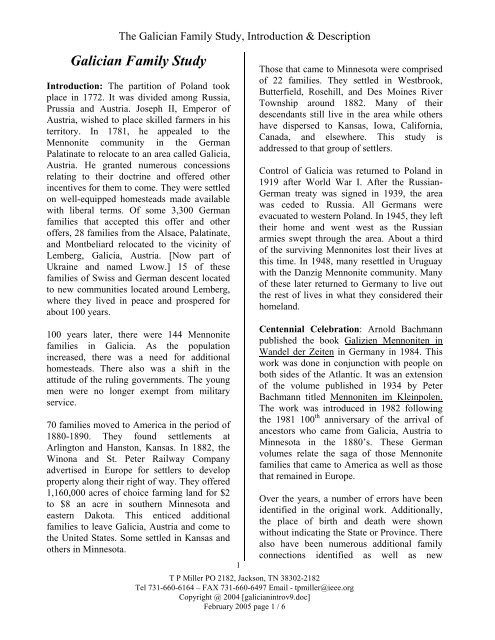
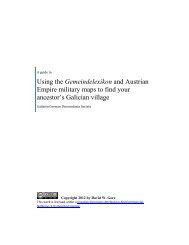
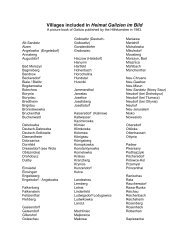
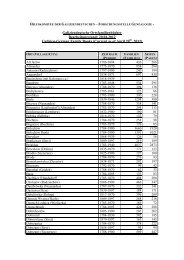
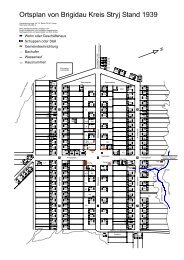

![All in the [Rupp] family - Galizien German Descendants](https://img.yumpu.com/21014069/1/190x245/all-in-the-rupp-family-galizien-german-descendants.jpg?quality=85)
